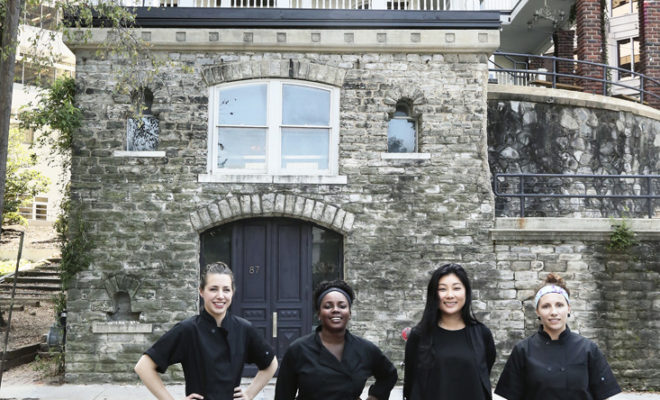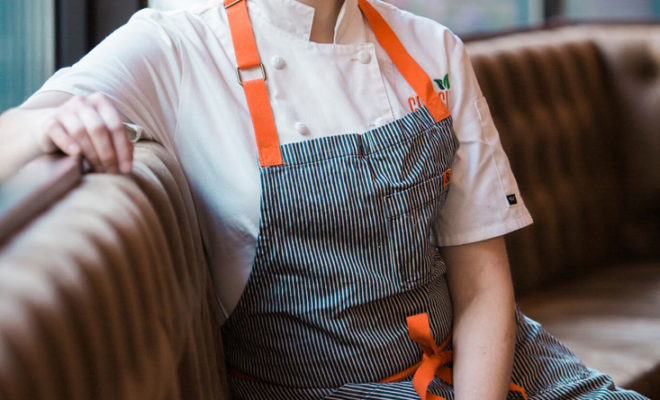Thank You for Smoking

Give this outdoor-ready cooking technique a try
STORY: Lia Picard | PHOTO: Erik Meadows
Smoking is a cooking technique used all over the world, but in our backyards it may be tempting to toss it aside for the quicker method of grilling.
Although grilling takes less time, smoking deserves its place in the sun, too. Besides achieving a mouthwatering, earthy flavor, smoking meats makes tough pieces tender. Michael Bertozzi, executive chef at Old Fourth Ward’s Two Urban Licks, gives us the scoop on how to ace smoking.
“Most of the stuff we do at Two Urban Licks is done over a wood fire grill, a rotisserie over a wood fire or in a wood fire oven,” Bertozzi says. “And then we have a J&R smoker in the prep kitchen. I spend most of my time around it.”
The first thing people should know about smoking is which wood to use and not use. Bertozzi recommends oak for beginners as it’s a medium bodied wood that imparts a smoky flavor without being overpowering. For a little more oomph, choose hickory, which leaves a bacon fat flavor. And there are fruit woods such as pecan, cherry, peach and apple that impart a slight sweetness. The heaviest flavored wood of the bunch is mesquite. Once you know which one you like, you can get creative—think blending oak and a fruit wood. The one wood not to use? Pine. It releases a sap that makes your meat inedible.
Next, it’s time to choose a smoker. The Big Green Egg reigns supreme in the South, but it’s not what Bertozzi prefers. “The best smokers to use are offset barrel smokers. The firebox is on the side, and the chimney is on the opposite end, so what you’re doing is creating a convection current,” he explains. In a Big Green Egg, the meat is directly over the heat source, and it can’t be controlled. Offset smokers range from $100 to $2,000.
If you’ve been to a barbecue restaurant you know that the most common meats to smoke are brisket, pork shoulder and beef short ribs. What you may not know is the brine vs. rub debate. A brine is a salty solution where meat is soaked for a period of time before cooking. A rub, on the other hand, is a dry mixture of spices. Bertozzi’s stance is circumstantial. “Pork benefits from being brined just to get salt into its interior,” he says. Brisket is a fattier meat, so a rub works better. The fat melts as it cooks and infuses the flavor into the meat.
Whether you’re team brine or rub, the fun doesn’t stop at smoking meat. Mushrooms are one of Bertozzi’s favorite foods to smoke over hickory. He simply tosses oyster and trumpet mushrooms in olive oil and salt and smokes them for 30 minutes. “They get enough of that smoky flavor that it makes them taste meaty.” Then he throws them in a stir fry and has a simple dish with an added layer of flavor. He also likes to smoke oysters on the half shell and salmon.
When it comes to smoking, the most important thing to remember is patience—there’s a reason they say “low and slow.” Too often people try to rush through smoking by cranking up the heat, but all that does is overcook your meat. Plan on getting an early start (as in 6 a.m.) if you want your meat ready by dinner time. Ready to start smoking? Bertozzi shares a recipe above.
TWO Urban Licks
820 Ralph McGill
Blvd. N.E., 30306
404.522.4622
twourbanlicks.com
READY, SET— GET SMOKING!
SMOKED BRISKET
Yields 20 servings
Plan on this recipe taking 12-14 hours
1 prime brisket, 16 to 18 lbs.
¼ c. kosher salt
¼ c. freshly ground pepper
TOOLS NEEDED:
Smoker
Hickory or oak logs for smoking
1 roll of butcher paper (not waxed)
1 probe thermometer
DIRECTIONS: Start a fire in the smoker and allow the chamber to reach a temperature of 275 degrees. Season brisket with salt and pepper (use more as needed). Place brisket in the center of the smoker and close the door. Watch the heat of the smoker—if it drops from 275 degrees, add a one or two logs. About eight hours in, check the temperature of the thickest part of the brisket. Once the brisket has reached an internal temperature of 160 degrees, remove and wrap in butcher paper, ensuring that no part is exposed. Return to the smoker and continue cooking until the brisket reaches an internal temperature of 203 degrees (begin checking every 45 minutes to an hour). Serve with sauce (recipe follows), pickles, shaved yellow onion and white bread.
MUSTARD BBQ SAUCE
2 c. French’s yellow mustard
1 ½ tsp. onion powder
1 ½ tsp. garlic powder
1 tsp. hickory powder (usually
found at local butcher shop)
1 ½ tsp. cracked black pepper
2 tbsp. brown sugar
2 tbsp. apple cider vinegar
2 tbsp. hot sauce (such as Texas Pete)
2 tbsp. Worcestershire sauce
3 tbsp. bourbon
1 tbsp. ketchup
2 tbsp. honey
DIRECTIONS: Combine in a small sauce pot and heat over medium heat until the sauce simmers. Cook until thick (about 10 minutes).













